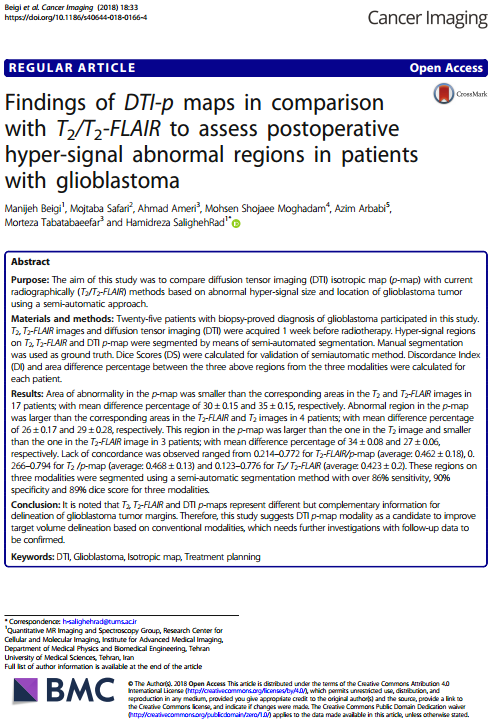Findings of DTI-p maps in comparison with T2/T2-FLAIR to assess postoperative hyper-signal abnormal regions in patients with glioblastoma
Abstract
Objective:
The aim of this study was to compare diffusion tensor imaging (DTI) isotropic map (p-map) with current radiographically (T2/T2-FLAIR) methods based on abnormal hyper-signal size and location of glioblastoma tumor using a semi-automatic approach.
Results:
Area of abnormality in the p-map was smaller than the corresponding areas in the T2 and T2-FLAIR images in 17 patients; with mean difference percentage of 30 ± 0.15 and 35 ± 0.15, respectively. Abnormal region in the p-map was larger than the corresponding areas in the T2-FLAIR and T2 images in 4 patients; with mean difference percentage of 26 ± 0.17 and 29 ± 0.28, respectively. This region in the p-map was larger than the one in the T2 image and smaller than the one in the T2-FLAIR image in 3 patients; with mean difference percentage of 34 ± 0.08 and 27 ± 0.06, respectively. Lack of concordance was observed ranged from 0.214–0.772 for T2-FLAIR/p-map (average: 0.462 ± 0.18), 0.266–0.794 for T2 /p-map (average: 0.468 ± 0.13) and 0.123–0.776 for T2/ T2-FLAIR (average: 0.423 ± 0.2). These regions on three modalities were segmented using a semi-automatic segmentation method with over 86% sensitivity, 90% specificity and 89% dice score for three modalities.
Conclusion:
It is noted that T2, T2-FLAIR and DTI p-maps represent different but complementary information for delineation of glioblastoma tumor margins. Therefore, this study suggests DTI p-map modality as a candidate to improve target volume delineation based on conventional modalities, which needs further investigations with follow-up data to be confirmed.

